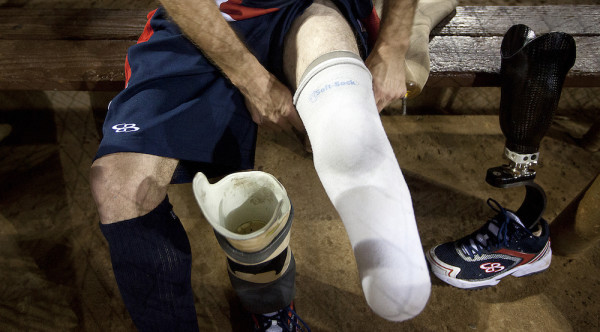

Between 2001 and 2016, the Global War on Terror left more than 1,650 service members as amputees. Though prosthetics have helped to alleviate some of the struggles of their loss of limb, they experience a “lower health-related quality of life” compared to injured troops without amputations, according to recent DoD research.
To address this issue, the U.S. Army is studying the science of bone, skin and muscle regeneration so an amputation is no longer permanent for future service members injured in combat.
“We’re not quite there yet,” Army Lt. Col. David Saunders, extremity repair product manager for the U.S. Army Medical Materiel Development Activity, said in a news release. “What we’re trying to do is develop a toolkit for our trauma and reconstructive surgeons out of various regenerative medicine products as they emerge to improve long-term outcomes in function and form of injured extremities.”

At the Military Health System Research Symposium, held this week in Kissimmee, Florida, the military’s leading researchers and academics discussed “extremity regeneration,” particularly the use of synthetic grafts, which can kickstart the healing process for soldiers by regenerating tissue.
“We would like it to be as restorative as possible, resist infection … and be durable,” Saunders said. “This is going to be implanted in young people who may go on to live another 60 to 70 years.”
Stephanie Shiels, who works with the U.S. Army Institute of Surgical Research, is looking to go a step further and regrow bones. She has been working on a “synthetic bone gap filler” that reduces the possibility of infection by placing antimicrobial agents in the grafts.
“We know that it reduces infection,” Shiels said in the release. “Other things to consider include adding a bulking agent … to help regenerate bone.”

Though limb regeneration is the ultimate goal, the Army is also focused on skin regeneration — a major problem for both soldiers and civilians.
“Warfighters and civilians alike suffer large surface and burns, and these result in medically and cosmetically problematic scars,” Jason Brant, a researcher with the University of Florida, said in the release. “The impacts of these scars … are really staggering. The ability to develop effective therapies will have an enormous impact not only on the health care system but on the individuals as well.”
Brant is studying the African spiny mouse, which can regenerate scar-free skin, even after losing mass amounts in an attack. Brant believes if he can determine how the mouse regenerates skin, he may be able to unlock how to apply it to people.
Advancements in science on a number of fronts have led to a whole array of innovations to treat skin injury. In 2014, the Army was experimenting with 3D printers to generate new skin. Last year, a number of doctors reportedly began using fish scales to treat burn and explosion victims.
As a kid, I recall picking up a salamander that was soaking up summer sun on the siding of my childhood home. When he realized he might be in danger, he dropped his tail and fled for the bushes, only to grow a new one almost immediately. Wouldn’t it be incredible if a soldier injured on the battlefield could do the same?
